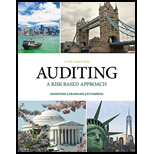
Auditing: A Risk Based-Approach (MindTap Course List)
11th Edition
ISBN: 9781337619455
Author: Karla M Johnstone, Audrey A. Gramling, Larry E. Rittenberg
Publisher: Cengage Learning
expand_more
expand_more
format_list_bulleted
Question
Chapter 5, Problem 2RQSC
a.
To determine
Introduction: The auditor is appointed by the company in order to get their financial statements checked whether they are authentic or reliable for further usage by the shareholders and other users.
The pros and cons of having auditing standards for both public and nonpublic companies.
b.
To determine
Introduction: Auditor is appointed by the company in order to get their financial statements checked whether they are authentic or reliable for further usage by the shareholders and other users.
The difference between auditing standards for public and non-public companies.
Expert Solution & Answer
Want to see the full answer?
Check out a sample textbook solution
Students have asked these similar questions
Choice best answer
General accounting
None
Chapter 5 Solutions
Auditing: A Risk Based-Approach (MindTap Course List)
Ch. 5 - Prob. 1CYBKCh. 5 - Prob. 2CYBKCh. 5 - Prob. 3CYBKCh. 5 - Prob. 4CYBKCh. 5 - Prob. 5CYBKCh. 5 - Prob. 6CYBKCh. 5 - Prob. 7CYBKCh. 5 - Prob. 8CYBKCh. 5 - Prob. 9CYBKCh. 5 - Prob. 10CYBK
Ch. 5 - Prob. 11CYBKCh. 5 - Prob. 12CYBKCh. 5 - Prob. 13CYBKCh. 5 - Prob. 14CYBKCh. 5 - Prob. 15CYBKCh. 5 - Which of the following accounts would not be...Ch. 5 - Prob. 17CYBKCh. 5 - Prob. 18CYBKCh. 5 - Prob. 19CYBKCh. 5 - Which management assertion is usually most...Ch. 5 - Prob. 21CYBKCh. 5 - Prob. 22CYBKCh. 5 - Prob. 23CYBKCh. 5 - Prob. 24CYBKCh. 5 - Prob. 25CYBKCh. 5 - Prob. 26CYBKCh. 5 - Prob. 27CYBKCh. 5 - Prob. 28CYBKCh. 5 - Prob. 29CYBKCh. 5 - Prob. 30CYBKCh. 5 - Prob. 31CYBKCh. 5 - Prob. 32CYBKCh. 5 - Prob. 33CYBKCh. 5 - Prob. 34CYBKCh. 5 - Prob. 35CYBKCh. 5 - Prob. 36CYBKCh. 5 - Prob. 37CYBKCh. 5 - Prob. 38CYBKCh. 5 - Prob. 39CYBKCh. 5 - Prob. 40CYBKCh. 5 - Prob. 41CYBKCh. 5 - Prob. 42CYBKCh. 5 - Prob. 43CYBKCh. 5 - Prob. 44CYBKCh. 5 - Prob. 45CYBKCh. 5 - Prob. 46CYBKCh. 5 - Prob. 47CYBKCh. 5 - Prob. 48CYBKCh. 5 - Prob. 1RQSCCh. 5 - Prob. 2RQSCCh. 5 - Prob. 3RQSCCh. 5 - Prob. 4RQSCCh. 5 - Prob. 5RQSCCh. 5 - Prob. 6RQSCCh. 5 - Professional guidance indicates that the auditor...Ch. 5 - Identify the accounts associated with the...Ch. 5 - Assume that an organization asserts that it has...Ch. 5 - Prob. 10RQSCCh. 5 - Prob. 11RQSCCh. 5 - Prob. 12RQSCCh. 5 - Prob. 13RQSCCh. 5 - List factors that might affect an audit firm’s...Ch. 5 - Prob. 15RQSCCh. 5 - Prob. 16RQSCCh. 5 - Prob. 17RQSCCh. 5 - Prob. 18RQSCCh. 5 - Prob. 19RQSCCh. 5 - Prob. 20RQSCCh. 5 - Prob. 21RQSCCh. 5 - Prob. 22RQSCCh. 5 - Prob. 23RQSCCh. 5 - Prob. 24RQSCCh. 5 - Prob. 25RQSCCh. 5 - Prob. 26RQSCCh. 5 - Prob. 27RQSCCh. 5 - Prob. 28RQSCCh. 5 - Prob. 29RQSCCh. 5 - Prob. 30RQSCCh. 5 - Prob. 32RQSCCh. 5 - Prob. 33RQSCCh. 5 - Prob. 34RQSCCh. 5 - Prob. 35RQSCCh. 5 - Prob. 36RQSCCh. 5 - Prob. 37RQSCCh. 5 - Prob. 38RQSCCh. 5 - Prob. 39RQSCCh. 5 - Prob. 40RQSCCh. 5 - Prob. 42RQSCCh. 5 - Prob. 43RQSCCh. 5 - Prob. 44FF
Knowledge Booster
Similar questions
- Branton Ltd. had cash sales of $56,390, credit sales of $42,810, sales returns and allowances of $6,450, and sales discounts of $5,120. The company's net sales for this period___. A. $88,200 B. $87,630 C. $92,180 D. $93,830 E. $95,900arrow_forward5 PTSarrow_forwardWhat is the gross profit margin of this accounting question?arrow_forward
- What is the differential revenue?arrow_forwardDon't use ai given answer general accountingarrow_forwardArdor Ltd. purchased a new equipment that is expected to be used in operations for 6 years for $60,000. The salvage value of the equipment after 6 years is $6,000. Assume the equipment was purchased on the first day of the fiscal year so no partial-year depreciation is needed. Using the Straight-Line Depreciation Method, what is the value of accumulated depreciation at the end of year 4?arrow_forward
arrow_back_ios
SEE MORE QUESTIONS
arrow_forward_ios
Recommended textbooks for you
 Auditing: A Risk Based-Approach (MindTap Course L...AccountingISBN:9781337619455Author:Karla M Johnstone, Audrey A. Gramling, Larry E. RittenbergPublisher:Cengage Learning
Auditing: A Risk Based-Approach (MindTap Course L...AccountingISBN:9781337619455Author:Karla M Johnstone, Audrey A. Gramling, Larry E. RittenbergPublisher:Cengage Learning Auditing: A Risk Based-Approach to Conducting a Q...AccountingISBN:9781305080577Author:Karla M Johnstone, Audrey A. Gramling, Larry E. RittenbergPublisher:South-Western College Pub
Auditing: A Risk Based-Approach to Conducting a Q...AccountingISBN:9781305080577Author:Karla M Johnstone, Audrey A. Gramling, Larry E. RittenbergPublisher:South-Western College Pub

Auditing: A Risk Based-Approach (MindTap Course L...
Accounting
ISBN:9781337619455
Author:Karla M Johnstone, Audrey A. Gramling, Larry E. Rittenberg
Publisher:Cengage Learning

Auditing: A Risk Based-Approach to Conducting a Q...
Accounting
ISBN:9781305080577
Author:Karla M Johnstone, Audrey A. Gramling, Larry E. Rittenberg
Publisher:South-Western College Pub
